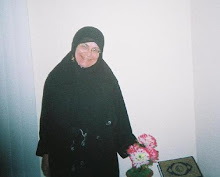Violence against women and the rise of ‘torture porn’
 May 7, 2007
May 7, 2007By Kira Cochrane
STANDFIRST- Mainstream movies are getting darker and more violent. And as Quentin Tarantino’s latest project, Grindhouse, demonstrates, the worst of the violence is often directed at women. Kira Cochrane on the rise of ‘torture porn’
Talking about his upcoming film Hostel II at a press junket recently, the young director Eli Roth couldn’t contain his enthusiasm for the poster devised by the film’s marketing team - a close-up of some sinewy, gleaming boar meat. “Any time people see women in a horror film,” he noted, “they say, ’Oh, these girls are just pieces of meat.’ And, literally, in Hostel Part II, that’s exactly what they are. They are the bait, they are the meat, they are the grist for the mill. So I thought it was actually a really smart poster... and really, really disgusting! I love it.”
Unless you have a taste for seriously gory films, chances are you haven’t heard of Roth. Last year, though, the first instalment of Hostel - the story of a Slovakian boarding house where rich men pay to enact tortures on unwitting victims - was a massive hit, topping the US box office on its opening weekend. The trailer promised that, ”There is a place where your darkest, sickest fantasies are possible, where you can experience anything you desire,” and the film strove to live up to that promise. Hostel’s most famous scene shows a man taking a blowtorch to a woman’s face, her eyeball coming out and dangling from the socket. Later, another character snips it off with some scissors.
Horror films have, of course, always been full of nasty, misanthropic imagery. In many other films, extreme, sexualised violence against women has frequently been a theme (Clockwork Orange, Boxing Helena and many others spring to mind). But recently the levels of horrific violence on show at the multiplexes - and the sheer cynicism of the films involved - have gone through the roof. And a lot of the most nasty, unrepentant and terrifyingly pointless violence is aimed at women. At least Clockwork Orange had a political point to make. (There can be no excuses for Boxing Helena.)
Hostel is just part of a new subgenre of horror films which are so dehumanising, nasty and misogynist that they are collectively known either as “gorno” (a conflation of “gory” and “porno”), or, more commonly, as “torture porn”. Other films that make it into the torture porn category are Wolf Creek, Turistas and The Devil’s Rejects, with each new film promising higher levels of violence - guaranteeing not just a considerable body count, but long, lingering scenes of terror, torture and pain.
In most of these films, both men and women end up being sliced, gored, dismembered, decapitated. In that sense they offer audiences equal-opportunity gore. But it’s the violence against women that’s most troubling, because it is here that sex and extreme violence collide.
The publicity campaigns for many of these films flag up the prospect of watching a nubile young woman being tortured as a genuinely pleasurable experience. So, for instance, a recent US billboard campaign for the upcoming (mainstream) film Captivity featured the film’s star Elisha Cuthbert (just voted the 10th sexiest woman in the world by the young male readers of FHM magazine) in a series of four photographs. In the first (labelled ABDUCTION) a black-gloved hand covers her mouth. The second (CONFINEMENT) shows her, with bloody fingers, struggling to get out of a cage. The third (TORTURE) has her face encased in an odd white mask, tubes shoved up her nose, and apparently filled with blood. Finally, under the word TERMINATION, she is shown laid out, apparently dead.
The billboard attracted a barrage of complaints, with Jill Soloway (one of the writers of Six Feet Under) leading a campaign against it - the poster was soon taken down. In a piece on the Huffington Post website, Soloway wrote that the images were “the most repulsive, horrifying, woman-hating, human-hating thing I have ever seen in public” and didn’t just represent “horror, this wasn’t just misogyny... It was a grody combo platter of the two, the torture almost a punishment for the sexiness. It had come from such a despicable inhuman hatred place that it somehow managed to recall Abu Ghraib, the Holocaust, porn and snuff films all at once.” Joss Whedon, creator of the Buffy the Vampire Slayer TV series, agreed, writing in a letter to the MPAA, the US ratings board, that the ad campaign “is not only a literal sign of the collapse of humanity, it’s an assault... this ad is part of a cycle of violence and misogyny that takes something away from the people who have to see it. It’s like being mugged.”
 Many of today’s torture porn films are being made on tiny budgets by little-known directors, but with the release of the new Tarantino/Rodriguez double-bill, Grindhouse - designed as a tribute to the ultra-violent B-movie programmes of old - the trend officially reaches the mainstream. Made up of two films plus a clutch of trailers for non-existent movies, Grindhouse bombed when it was released in the US last month. American audiences were said to have been put off by the three-hour running time, and last week it was announced that Grindhouse will be released in a different format in the UK, the two films sold as separate features. Whether either film is any good is still up for debate - I, for one, found them both suicidally boring. What isn’t in question is the disturbing attitude towards women in these films.
Many of today’s torture porn films are being made on tiny budgets by little-known directors, but with the release of the new Tarantino/Rodriguez double-bill, Grindhouse - designed as a tribute to the ultra-violent B-movie programmes of old - the trend officially reaches the mainstream. Made up of two films plus a clutch of trailers for non-existent movies, Grindhouse bombed when it was released in the US last month. American audiences were said to have been put off by the three-hour running time, and last week it was announced that Grindhouse will be released in a different format in the UK, the two films sold as separate features. Whether either film is any good is still up for debate - I, for one, found them both suicidally boring. What isn’t in question is the disturbing attitude towards women in these films.
First on the programme is Robert Rodriguez’s Planet Terror, a repetitively gory, gloomily depressing zombie picture, which opens with Rose McGowan pole dancing. There are close ups of her bottom and breasts in those initial scenes, and then she appears to be kissing another woman. In a feature about Grindhouse in Rolling Stone last month (APRIL), Rodriguez noted that, “When we started talking about the movie, Quentin said, ’There should always be a lesbian kiss just around the corner - possibly.’ I took that to heart, and in my very first scene, I have two female tongues going at each other and licking. You find out that it’s Rose licking a mirror, but it gets across the idea that it could be around the corner at any time.”
So far, so predictable. It isn’t surprising that the film’s main female character is a go-go dancer - Rodriguez is, after all, the director who made Sin City, in which the female characters ran the gamut from prostitutes to strippers. But having established McGowan’s sexiness, in Planet Terror, the attacks on her begin. First a zombie rips off McGowan’s leg, and then Tarantino (playing a zombie soldier called Rapist Number One) holds a gun to her head, before threatening her with rape. You can currently buy a Rapist Number One action figure online for your kids, should you so wish.
Then there’s Tarantino’s Death Proof, in which Kurt Russell stars as Stuntman Mike, a guy who gets his kicks from stalking groups of gorgeous young women, following them in his car and ramming whatever vehicle they happen to be travelling in, until they are dead. Severed limbs and bloodied faces abound. Interestingly, of all the women actors in Grindhouse, McGowan is the only one to appear in both films, and, while she survives Planet Terror (fitting the age-old horror archetype of the “final girl” who persists to the end - usually, it seems, to help justify the misogyny that has gone before) this triumph is short-lived. In Death Proof, McGowan’s character is swiftly - gruesomely - dispatched. (In that same Rolling Stone feature, McGowan talked about her own attitude towards today’s horror films, saying that, “all they do now is think about ways to torture women, primarily. I don’t really get that. What is this, a manual for young, budding serial killers? Can’t we just go watch Pillow Talk?”)
Some of the nastiest images in Grindhouse arise in the fake trailers. Rob Zombie, director of The Devil’s Rejects, creates one for a dream project - Werewolf Women of the SS - which includes the image of a topless woman, bound and gagged, being tortured by cartoonish Nazi soldiers. And Eli Roth - him again! - packs a host of sex and gore into his three-minute trailer for a potential film called Thanksgiving, including an image of a cheerleader peeling off her clothes while bouncing on a trampoline, before apparently being impaled with a large, gleaming knife - through the vagina, no less. (Horrifying though this is, it isn’t actually original - the 2005 film Chaos showed a woman being anally raped with a knife.)
Unsurprisingly, the cheerleader scene in Grindhouse attracted some attention from the MPAA, the US ratings board, and Roth was forced to change it, to make the imagery much more suggestive than explicit. Addressing this at the American press junket for Grindhouse, he commented that “when I shot that trailer for Thanksgiving, I really thought there was no problem with anything - it just shows you how genuinely out of touch I am! I was like... a full frontal labial shot, to camera, of a girl landing on a knife seemed like no problem to me... “
Of course, maybe Roth’s just trying to be funny - his tone is gleeful throughout this interview (a transcript and audio version of which can be found on a number of film websites). Later in the interview he says: “Let me tell you, I heard that Stanley Kubrick did a lot of takes on Eyes Wide Shut, it was nothing compared to the amount of takes we did once we had that cheerleader naked and bouncing around on a trampoline! I mean, she was great, she got it on the first take, but we did take, after take, after take! And we finished early and we had like three hours, and we’re like, ’Well, how much film do we have?’ And we’re like, ’All right, let’s... let’s do it again!’ And she just had a smile on her face the whole time.”
Grindhouse is, in many ways, a cartoon, and its intersection of sex and violence is meant to be ironic, funny even. It makes multiple nods to parody and pastiche. I’m not so sure that British audiences will share the directors’ humour though. As one of the stars of Planet Terror, the British actor Naveen Andrews, has said on the subject of the B-movie films Grindhouse is based on: “Obviously, Quentin and Rodriguez saw some kind of aesthetic in these kinds of films, and for the life of me I was trying to grasp what it was. They were laughing like maniacs and I didn’t find it funny for more than like a minute.”
Over the years, many directors have defended the violence in their films by claiming that it’s ironic. But is an image of a nubile woman having her innards pulled out - as occurs in Planet Terror - any less problematic because it has been made in a knowing way? You could argue that it’s more problematic. Irony - with its inherent insincerity - can be an emotionally deadening tool, and, in terms of their content, these films are already deadening, de-sensitising enough. The irony just adds another layer of soul-sucking cynicism to the mix.
Watching Grindhouse, I felt fundamentally depressed: who would seek out this experience as entertainment? What is more depressing is the fact that such films seem to be part of a wider trend towards the mainstream depiction of women as highly sexualised bait and prey: meat, as Roth had it. Over the past year, for example, we’ve seen mainstream fashion images that have shown highly made up, designer- clad women being brutalised (Italian Vogue), apparently about to be gang raped (a Dolce and Gabbana ad), and shot, stabbed and electrocuted (America’s Next Top Model). On shows such as CSI and its many spin-offs and imitators, the victims of each weekly murder case are, disproportionately, nubile young women. Lisa de Moraes of the Washington Post came up with an apt shorthand for such series in 2005, dubbing that year’s programmes the “season of Die, Women, Die!”.
Of course, watching one of these films won’t turn a sane, decent individual into a killer or a torturer, but you have to wonder what effect this widespread meshing of sexuality and graphic violence will have on the young men at whom they are primarily aimed. The clear logic behind all these films, TV shows and images appears to be that if a young, good-looking, barely-clad woman is sexy while alive, she’s even sexier when she’s being tortured, or when she’s a bloody corpse.
In an article in Newsweek last year, Tony Timpone, editor of the horror magazine Fangoria, commented that “in 1990, I had to pull my hair out just to find a movie to put on the cover. There were only three or four major horror releases a year. Now there are three or four a month. We’re like pigs in slop.” That’s not a bad way of putting it.
Hostel 2 Trailer
Hostel Trailer
All I can add to this, is there is some very sick people out there; whether they are in the film industry or what other dark underside that is inhumane.
Further Reading:
Morality in Islam
Labels: End of Time















0 Comments:
Post a Comment
<< Home